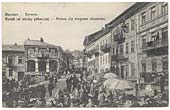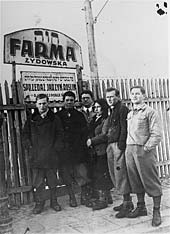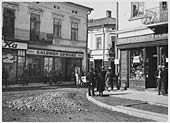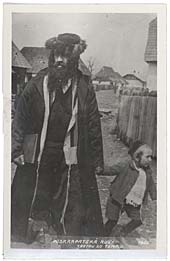- Exhibition presentation
- The Jews in Ukraine
- The start of a genocidal policy
- Radicalization of the genocide
- Father Patrick Desbois and Yahad-In Unum
- The stages of execution
- Panoramic views of the exhibition
The Holocaust by bullets - Shoah Memorial
The Jews in Ukraine
At the eve of the twentieth century, the immense majority of the Russian Empire’s 5 400 000 Jews lived in the “Residence Zone” (mainly in Ukraine, but also Belarus, Lithuania and a part of Poland). It was there that, to use Vassili Grossman’s expression, the main body of Jewish people, was to be found… They spoke Russian, German, Polish and above all Yiddish, and were united by the same culture, even if a large number of them had turned away from religion, becoming involved in the political and social struggle. Despite continuous changes in sovereignty, the Jews felt they belonged more to a region, town or shtetl rather than a specific country.
The consequences of the First World War (Non-Soviet Ukraine)
At the outcome of the First World War, the Central Empires (the German Reich, Austria-Hungary) disappeared, and the Bolshevik Revolution in the ex-Russian Empire led to enormous upheavals, dislocating Ukraine, splitting up its territory and populations, and notably the Jewish population, into the different countries formed by the peace treaties. Jews’ lives in the following period differed greatly (depending on political circumstance and the area in which they were living).
Although the brief Popular Republic of Ukraine (January 1918-November 1920), granted the Jewish community the right to manage their own religious, cultural and educational institutions, pogroms involving every national and political force were nevertheless perpetrated.
The situation in the Ukrainian regions attached to Poland were no better. Jews’ lives there began to deteriorate as of 1926 (the year of S.Pilsudski’s coup d’Etat): businesses and shops were boycotted, official quota systems were introduced in educational establishments…
In Rumania, the rise of anti-Semitism and the growing influence of racist and totalitarian theories led to the formation of extreme right Rumanian nationalist movements and of Ukrainian independent parties becoming more and more Fascist.
On the other hand, the Jewish population of trans-Carpathian Ukraine, attached to Czechoslovakia, had a relatively peaceful existence between the Wars. Following the Munich crises of 1938, the region was eventually annexed by Hungary. The Jewish population then became to suffer discrimination and persecution.
Soviet Ukraine before the Holocaust
During the initial years of the Soviet regime, their first political decisions led the Jews to believe that they had finally found their place in the USSR, and, more particularly, in Soviet Ukraine. The 1920’s-30’s were, however, to be lined with great disillusion for them both economically and socially, with a number of measures being announced leading to the disintegration of the Jewish world. Only in the cultural domain were the 1920s and 30’s a golden age. Yiddish became an official language, and developed on a grand scale: it was used in some regions administratively, and lessons were taught in Yiddish in states schools, while Yiddish newspapers, magazines, theaters and concert halls flourished.
1939
In 1939, the USSR annexed the East of Poland, as agreed in the German-Soviet pact, and then, in 1940, northern Bucovina. It is estimated that the Jewish population in Ukraine was then 2 500 000 (5 million in the USSR). Nearly 300 000 Jews fleeing the western territories of Poland which had been annexed by Germany, attempted to take refuge in the USSR. Considered “activists”, the refugees were sent to prisons or work camps in their thousands. They nevertheless succeeded in evading the fate of the 3 million Jews assassinated by the Nazis on Soviet land…

Buczacz-Buchach-Bukach (Galicia): Simon Wiesenthal's home town. The marketplace.
©Coll.CDJC/Shoah Memorial

Stanislawow, Stanislau, Stanislav (Galicia). The billboard reads : Jewish farm. Vegetables for sale every day.
©USHMM, courtesy of Yahd Vashem Photo Archives

Kolomyja-Kolomyya-Kolomea in Galicia (1935). The writing on the shop panels is in German, Ukrainian, Polish and Yiddish.
©USHMM, courtesy of Sueddeutscher verlag Bilderdienst

Jews from the Mukatchevo (Mukatch) region, Subcarpathian Ruthenia. The caption in Czech reads: father taking his son to the synagogue.
©Coll. CDJC/Shoah Memorial